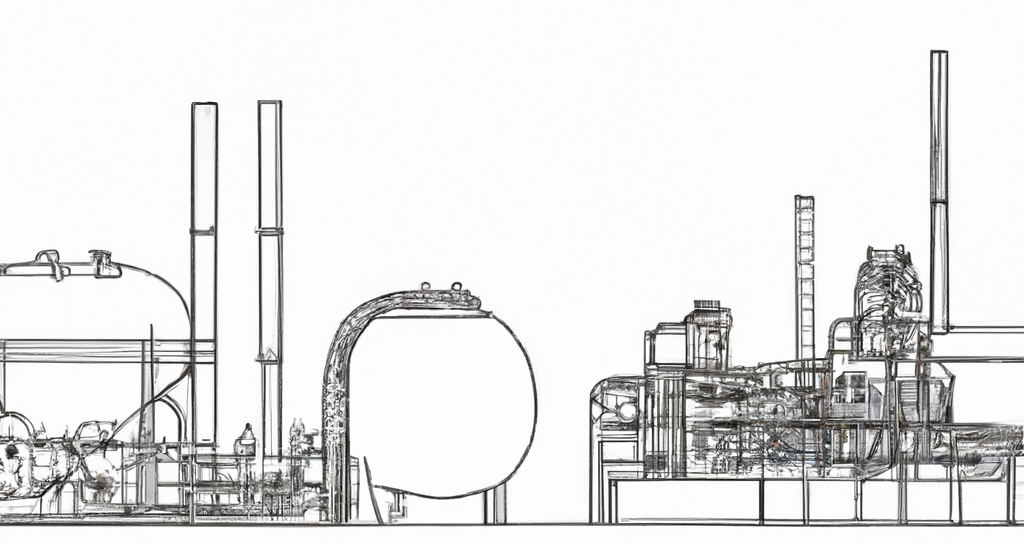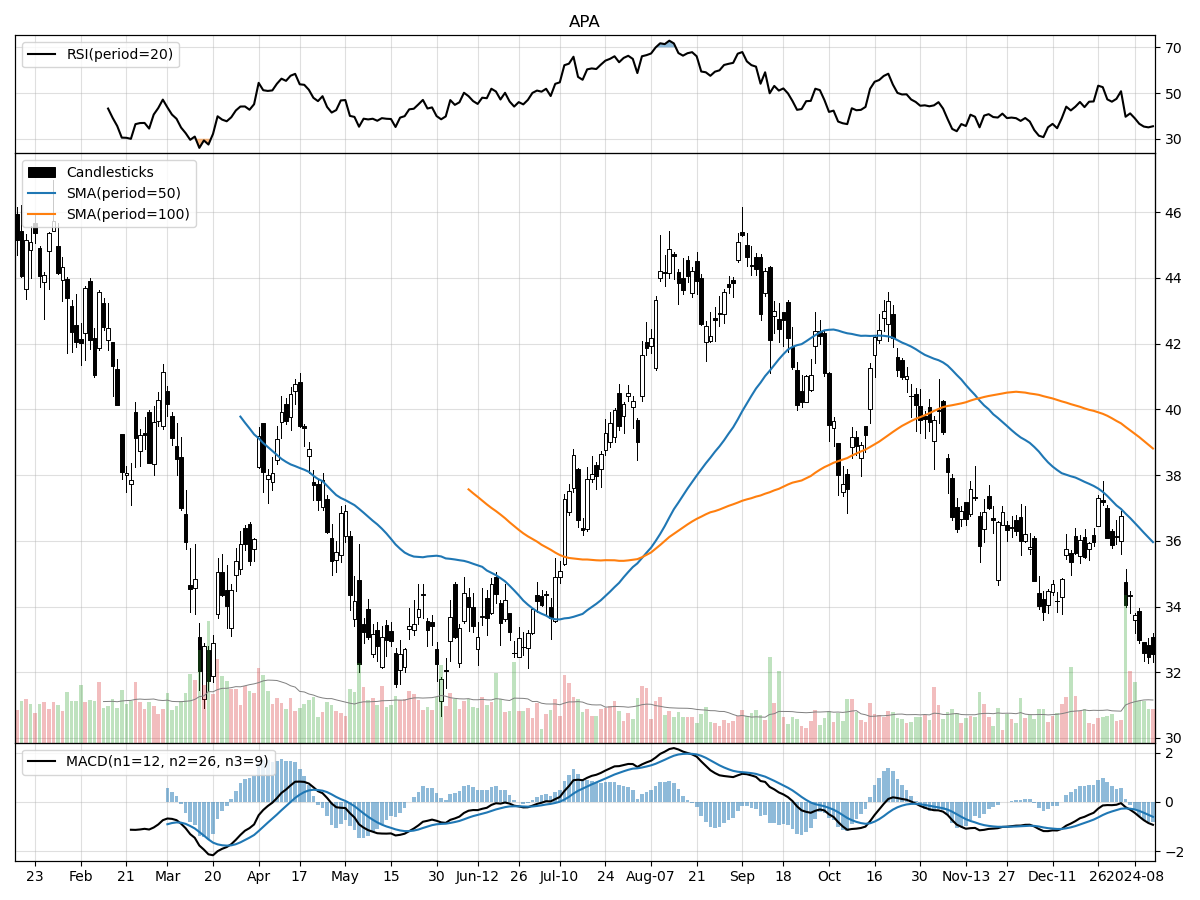APA Corporation (APA), Large Cap AI Study of the Week

January 16, 2024
Weekly AI Pick from the S&P 500
APA Corporation (APA)
Company Overview
APA Corporation is an independent energy company focused on the exploration, development, and production of natural gas, crude oil, and natural gas liquids (NGLs). The company has a strong presence in the United States, particularly in the Permian Basin, and also operates in Egypt, primarily in the Western Desert, and the North Sea in the U.K. APA Corp has also expanded its exploration activities to Suriname and holds interests in the Dominican Republic.
Following a holding company reorganization in March 2021, Apache Corporation became a wholly-owned subsidiary of APA Corp, which now trades on the Nasdaq under the ticker "APA." The company's strategy includes managing a diversified portfolio, investing in high-return projects, monetizing non-core assets, and streamlining operations like the deconsolidation of its midstream business to form Kinetik Holdings Inc.
The U.S. represents the largest portion of APA Corp's production and reserves, accounting for 53% of production and 68% of year-end proved reserves. The company's international operations, particularly in Egypt and the North Sea, also contribute significantly to its production and revenue. APA Corp's consolidated Egyptian operations have a favorable cost recovery and profit-sharing structure, and its joint venture with Sinopec accounts for a substantial part of its output and reserves.
In the North Sea, APA has a smaller but noteworthy presence, and the company's partnership with TotalEnergies in offshore Suriname has led to several hydrocarbon discoveries, signaling potential growth opportunities. APA Corp's total interests include nearly 11,000 oil and gas wells, with proved reserves comprising 403 million barrels of crude oil, 180 million barrels of NGLs, and 1.8 trillion cubic feet of natural gas.
In 2022, APA Corp added and acquired new proved reserves, largely in the U.S., and continued to invest in development projects both domestically and internationally. The company's proved undeveloped reserves increased slightly, with significant investments made to convert these to developed status. APA Corp's reserves are audited by third-party firm Ryder Scott for regulatory compliance.
Finally, the company's midstream business underwent a merger to create Kinetik Holdings Inc., with APA Corp initially holding a 79% stake, later reduced to about 13%. The Egyptian General Petroleum Corporation is another key contributor to APA Corp's revenue, emphasizing the importance of its international operations to the company's financial performance.
By the Numbers
Annual 10-K Report Summary:
- Net income for 2022: $3.7 billion (up from $973 million in 2021)
- Operating cash flow for 2022: $4.9 billion (41% increase from 2021)
- Debt reduction in 2022: $2 billion
- Common stock buyback in 2022: $1.4 billion
- Reduction in preferred interests in 2022: $712 million
- U.S. production decrease: 8%
- Egypt production improvement: Not quantified
- North Sea production: Dipped mid-year, recovered by Q4
- Suriname discoveries: Not quantified
- Oil revenues for 2022: $6.8 billion (44% increase in average realized prices)
- Production volumes increase from 2021 to 2022: Oil by 3%, natural gas by 4%, NGLs decreased by 6%
- Operating expenses for 2022: $1.8 billion (16% increase in lease operating expenses)
- Exploration expenses increase for 2022: $150 million
- G&A expenses increase for 2022: $107 million
- Net financing costs decrease for 2022: $135 million
- Income tax expenses increase for 2022: $1.1 billion
- 2023 budget for upstream capital investment: $2.0-$2.1 billion
- Expected production increase for 2023: 4-5%
- Net cash from operating activities for 2022: $4.9 billion (up from $3.5 billion in 2021)
- Sale of Kinetik shares in 2022: $224 million
Quarterly 10-Q Report Summary:
- Net income for Q3 2023: $459 million (up from $422 million in Q3 2022)
- Net income for the first nine months of 2023: $1.1 billion (down from $3.2 billion in the same period of 2022)
- Operating cash flows for the first nine months of 2023: $2.1 billion
- Share repurchases for the first nine months of 2023: 5.5 million shares for $208 million
- Dividends paid in the first nine months of 2023: $232 million
- U.S. production contribution: 55%
- Crude oil revenues for Q3 2023: $1.7 billion (slight increase from the previous year)
- Worldwide oil production increase for Q3 2023: 29.2 Mb/d to 207.8 Mb/d
- Natural gas revenues decrease for Q3 2023: $192 million to $236 million
- NGL revenues decrease for Q3 2023: $64 million to $138 million
- Year-to-date crude oil revenues decrease: $4.5 billion (down $785 million from 2022)
- Year-to-date gas revenues decrease: $583 million to $658 million
- Year-to-date NGL revenues decrease: $279 million to $375 million
- Operating expenses for Q3 2023: $1,476 million (down from $1,700 million in Q3 2022)
- Depreciation, Depletion, and Amortization costs increase for Q3 2023: Not quantified
- Net financing costs increase for Q3 2023: Not quantified
- Effective income tax rate for year-to-date 2023: Impacted by UK tax changes
- Deferred tax expense due to UK's Energy Profits Levy: $174 million in Q1 2023
- Capital investment projection for 2023: Around $2 billion
- Delaware Basin properties acquisition in 2023: $615 million
- Debt repurchase in 2023: $74 million (realizing a $9 million gain)
- Dividends paid to stockholders in 2023: $232 million (up from $127 million in 2022)
- Disbursements to Sinopec in 2023: $154 million (down from $237 million in 2022)
- Liquidity as of September 2023: $95 million in cash, $5.6 billion in total debt, $2.1 billion in total equity, $2.2 billion in available credit facilities
These figures provide a numerical snapshot of APA Corporation's financial performance and position based on the provided summaries of the annual and quarterly reports.
Stock Performance and Technical Analysis

When analyzing the technical aspects of a stock, traders and analysts often look at various indicators to assess the stock's performance and predict future price movements. For the stock in question, currently trading at $32.54, there are several technical factors to consider.
Firstly, the stock's current price is only 2% above its 52-week low and 28% below its 52-week high, which could indicate that the stock has been experiencing a downward trend over the past year. The recent price decline of 8.95% in the last month and 24.31% in the last three months further reinforces the bearish momentum in the short to medium term. This could be perceived as a potential buying opportunity if an investor believes the stock is undervalued and due for a rebound or, conversely, as a sign to hold off if the downward trend is expected to continue.
Volume is another critical indicator. The recent daily volume exceeds the longer-term average, suggesting increased trading activity. However, the Money Flow indicators point to moderate selling pressure and distribution, which typically means that more investors are selling their shares than buying, possibly driving the price down. A bearish Moving Average Convergence Divergence (MACD) of -0.60 aligns with this sentiment, indicating that the short-term momentum is currently weaker than the long-term momentum and that the stock may continue to experience bearish pressure.
When considering an investment, it's important to integrate these technical indicators with fundamental analysis, market conditions, and any recent news or events that could impact the company's performance. A bearish technical outlook, as suggested by the indicators for this stock, would generally lead to caution among investors. However, some may view the current prices as attractive for long-term investment if the fundamentals are strong, and there's a belief in the company's potential for recovery and growth. It is crucial to consider risk tolerance and investment horizon before making any decisions.

The ‘Bull’ Perspective
APA Corporation: A Stock to Buy Amidst Economic Headwinds
Summary:
- Resilient Production Growth: APA Corporation has demonstrated a robust increase in oil production, particularly from strategic U.S. locations, signaling strong operational capabilities.
- Attractive Capital Return Framework: With a commitment to return 60% of cash flow over capital investment to shareholders, APA's capital return strategy is a boon for investors seeking income and value.
- Strategic Asset Acquisitions: The company's strategic acquisition of Delaware Basin properties bolsters its resource base and long-term production outlook.
- Effective Cost Management: APA Corp has effectively reduced its operating expenses, showcasing its ability to manage costs amidst inflationary pressures.
- Diverse Portfolio and Risk Mitigation: Despite the identified risks, APA's diverse asset portfolio and proactive risk management strategies provide a hedge against market volatility.
Elaboration on Points:
- Resilient Production Growth
APA Corporation's production growth is a testament to its operational excellence. The company reported a significant increase in worldwide oil production, up 29.2 Mb/d to 207.8 Mb/d, primarily driven by increased drilling activity in the U.S., particularly in the prolific Midland and Delaware Basins. This growth comes despite the broader industry grappling with supply chain issues and regulatory challenges. APA's ability to ramp up production efficiently positions it well to capitalize on any upticks in commodity prices and signals a strong foundation for future growth. - Attractive Capital Return Framework
In a market where shareholder value is paramount, APA's capital return framework stands out. By repurchasing 5.5 million shares for $208 million and paying out $232 million in dividends, APA has demonstrated a shareholder-friendly approach. The company's pledge to distribute a significant portion of its cash flow back to investors is particularly compelling in a low-interest-rate environment where income is at a premium. This strategy not only offers immediate returns but also underlines management's confidence in the company's cash-generating abilities. - Strategic Asset Acquisitions
APA's strategic acquisition of properties in the Delaware Basin for $615 million is a calculated move to secure its future. The Delaware Basin is a sub-basin of the Permian Basin, known for its rich hydrocarbon resources. By strengthening its position in this key area, APA is set to enhance its production capabilities and reserves, which is crucial for long-term sustainability and growth. This proactive asset acquisition underscores APA's commitment to building a robust portfolio that can withstand market fluctuations. - Effective Cost Management
In an industry where cost efficiency is critical, APA Corp's ability to reduce its operating expenses from $1,700 million to $1,476 million in the third quarter is a remarkable achievement. This reduction in costs, even as the company expands its production, reflects a disciplined approach to capital allocation and operational management. By keeping its costs in check, APA is better positioned to navigate the challenges posed by inflation and the Fed's rate hikes, which could otherwise squeeze margins and profitability. - Diverse Portfolio and Risk Mitigation
While risks such as volatile commodity prices and geopolitical tensions persist, APA's diversified asset portfolio across key geographic regions, including the United States and Egypt, provides a natural hedge against localized risks. The company's proactive risk management strategies, such as hedging activities, aim to mitigate the impact of price volatility on revenues. Furthermore, APA's commitment to cybersecurity and operational safety minimizes the potential for disruptions that could adversely affect its financial stability.
In conclusion, APA Corporation presents a compelling investment opportunity, particularly for those who value growth combined with a strong commitment to shareholder returns. The company's strategic production increases, disciplined cost management, and proactive approach to risk mitigation contribute to its resilience in the face of economic headwinds. With a diversified asset base and a forward-looking management team, APA is well-positioned to navigate the challenges and capitalize on the opportunities that lie ahead in the energy sector.

The ‘Bear’ Perspective
APA Corporation: A Cautious Approach Amidst Market Headwinds
Summary:
- Volatile Commodity Prices: APA's financials are highly sensitive to fluctuations in oil, natural gas, and NGL prices, which have shown significant volatility in recent periods.
- Operational Risks and Capital Expenditure: The company faces substantial operational risks, and its capital expenditure is substantial, potentially limiting future growth if not managed effectively.
- Geopolitical and Regulatory Uncertainties: Geopolitical tensions and regulatory changes, particularly in the energy sector, pose significant risks to APA's international operations.
- Environmental and Cybersecurity Concerns: APA must navigate increasing environmental scrutiny and the ever-present threat of cybersecurity breaches.
- Debt and Liquidity Challenges: With a total debt of $5.6 billion and a complex liquidity situation, APA's financial maneuverability is constrained.
Elaboration:
- Volatile Commodity Prices
APA Corporation's recent financial performance, despite a net income increase in Q3 2023, has been a rollercoaster due to the volatile nature of commodity prices. The company's year-to-date net income plummeted to $1.1 billion from $3.2 billion in the previous year, largely due to the volatility of the commodity market. With crude oil revenues decreasing by $785 million and natural gas revenues down by $583 million from the previous year, it's clear that APA's profitability is at the mercy of market whims. This volatility, coupled with a 29.2 Mb/d increase in worldwide oil production, suggests a potential oversupply that could further depress prices. Investors should be wary of the inherent risks in a market where geopolitical events and pandemic-induced economic fluctuations can lead to sudden and unpredictable price swings. - Operational Risks and Capital Expenditure
Drilling and development, the lifeblood of APA's operations, come with significant risks and substantial costs. The company's capital expenditure for 2023 is projected at around $2 billion, a hefty sum that could strain finances if commodity prices don't cooperate. APA also faces operational risks, such as equipment failures and drilling inefficiencies, which could lead to increased costs and reduced output. For instance, the increase in Lease Operating Expenses and General and Administrative Expenses in Q3 2023, despite a reduction in overall operating expenses, highlights the ongoing cost pressures the company faces. Investors should consider the likelihood of these risks materializing and the potential impact on APA's bottom line. - Geopolitical and Regulatory Uncertainties
The global nature of APA's operations exposes it to various geopolitical and regulatory risks. Recent events in the Red Sea have led to increased shipping costs, as shown by the uptick in the World Container Index, illustrating how regional tensions can directly impact operational costs. Furthermore, APA's activities in the North Sea and Egypt are subject to political risk, which can disrupt operations and affect production levels. Regulatory changes, such as the UK's increased Energy Profits Levy and the US Inflation Reduction Act, also pose financial challenges. These uncertainties can lead to increased costs, lower profitability, and a need for constant strategic adjustments, making APA's stock a less attractive proposition for risk-averse investors. - Environmental and Cybersecurity Concerns
Environmental scrutiny is intensifying in the energy sector, and APA is no exception. The company must comply with stringent environmental regulations, which can increase operational costs and investment requirements. Additionally, cybersecurity threats pose a significant risk to APA's operational integrity and financial stability. Any significant breach could disrupt operations, lead to loss of proprietary data, and damage the company's reputation, potentially impacting the stock's value. - Debt and Liquidity Challenges
APA's liquidity situation is complex, with $5.6 billion in total debt and only $95 million in cash as of September 2023. The company's ability to manage this debt, particularly in a volatile commodity price environment, is crucial. APA's credit rating could be at risk of a downgrade, which would increase borrowing costs and further limit financial flexibility. The potential future obligations related to divested properties add another layer of financial uncertainty. Given these challenges, APA's financial position may not be robust enough to weather prolonged market downturns or unexpected operational setbacks, suggesting that a cautious investment approach may be prudent.




Comments ()